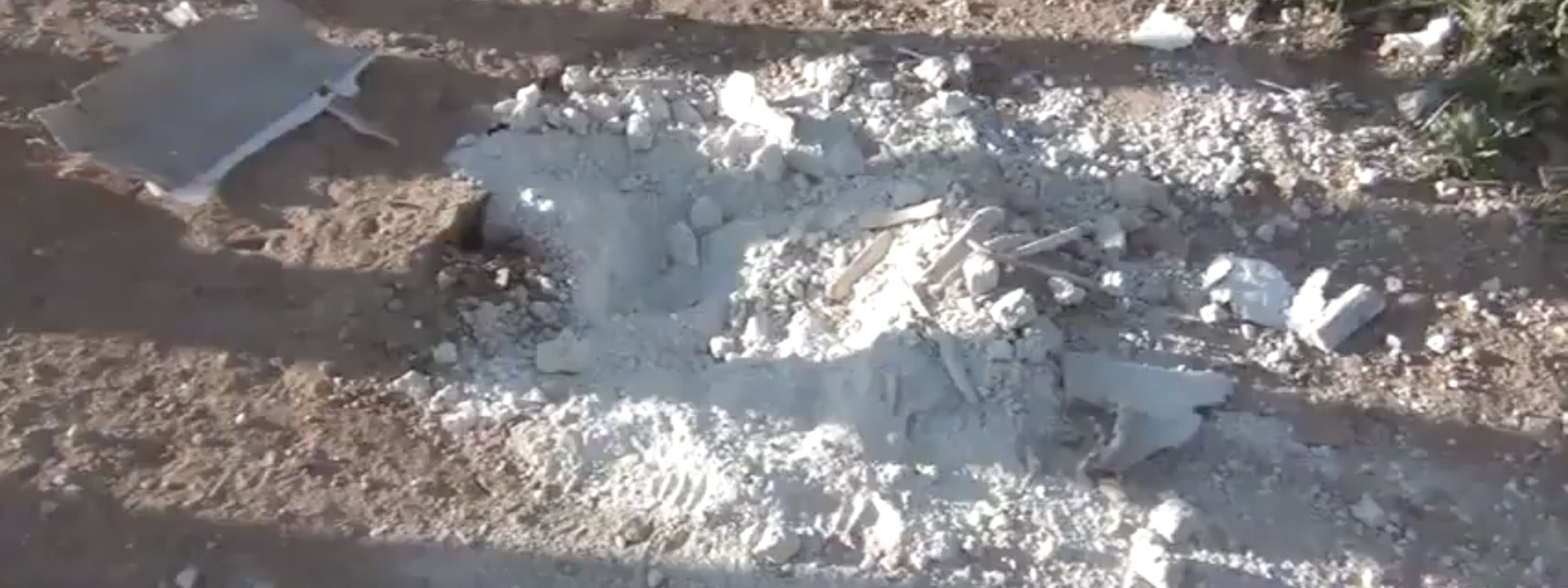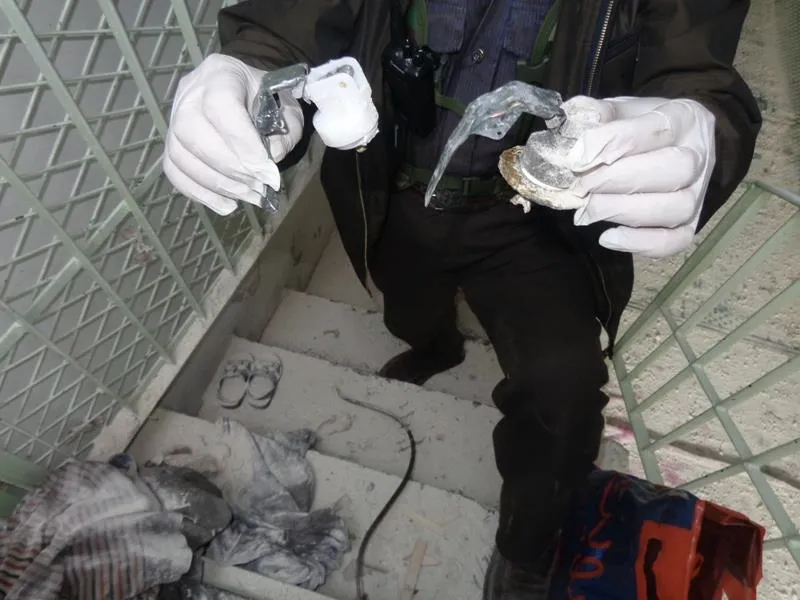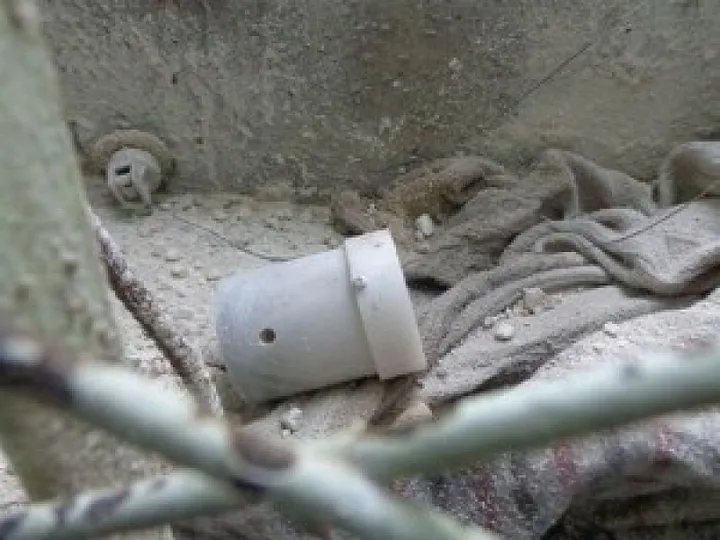Uncovered Chemical Weapons
New evidence from an official French report points to Assad’s repeated chemical weapon usage in Syria
Uncovered Chemical Weapons
Share this story

BANNER: Remains of an object allegedly dropped from a helicopter during a chemical weapons attack in Saraqeb, Idlib (source)
Introduction
The aftermath of the chemical attack on Khan Sheikhoun, Syria, on April 4, 2017, has produced a number of claims and theories about the type of chemical agent used, and the nature of the attack.
While the Russian and Syrian governments have attempted to spin the attack as a strike on some sort of rebel chemical weapon facility, despite the lack of any evidence to support those claims, open source evidence supports claims by Western governments that the attack was performed by the Syrian air force.
In the most recent such report, based on declassified intelligence and presented by the French government, a link is made between the specific type of sarin used in the attack and the sarin developed by the Syrian government’s chemical weapons program.
The significance of this report goes beyond the Khan Sheikhoun attack, adding to the weight of evidence that the Syrian government was behind three other sarin attacks, including the massive sarin attacks where hundreds of civilians were killed on August 21, 2013.
Chronicling Sarin Usage
The most revelatory aspect of the French report is not about the chemical attack in Khan Sheikhoun on April 4, 2017, but rather a chemical attack that took place nearly exactly 4 years ago, in the town of Saraqeb, Idlib.
As described in both the French report and by open source information at the time, a Syrian military helicopter flew over the town where three unidentified packages were thrown from the helicopter. The packages were described by some as boxes containing a cinderblock, with a white grenade inside that released a chemical agent. At two impact sites the grenades operated correctly, with one harmlessly landing at the side of a road, and a second landing in the courtyard of a house, killing one woman, and injuring several others. The impact site by the road can be seen below:
A later UN report would state the autopsy of the victim of the Saraqeb attack “clearly indicated signatures of a previous Sarin exposure.”
The French report reveals a great deal of information about this attack, in particular the specifics of the sarin used in the attack. The report states:
“At the third point of impact, an unexploded grenade was found in a crater on a dirt track. This munition was very similar in appearance to that found at the second point of impact.
Once the French services were sure of the traceability of the grenade, analyses were carried out.
The chemical analyses carried out showed that it contained a solid and liquid mix of approximately 100ml of sarin at an estimated purity of 60%. Hexamine, DF and a secondary product, DIMP, were also identified. Modeling, on the basis of the crater’s characteristics, confirmed with a very high level of confidence that it was dropped from the air.”
The presence of hexamine is particularly interesting, and is used in the French report to link the 2013 attack to the 2017 attack in Khan Sheikhoun, where it first states the samples from the 2017 attack contained hexamine:
“The analyses carried out by French experts on the environmental samples collected at one of the impact points of the chemical attack at Khan Sheikhoun on 4 April 2017 reveal the presence of sarin, of a specific secondary product (diisopropyl methylphosphonate — DIMP) formed during synthesis of sarin from isopropanol and DF (methylphosphonyl difluoride), and hexamine.”
And that hexamine is used in the production process of Syria’s sarin:
“According to the intelligence obtained by the French services, the process of synthesizing sarin, developed by the Scientific Studies and Research Centre (SSRC) and employed by the Syrian armed forces and security services, involves the use of hexamine as a stabilizer. DIMP is also known as a by-product generated by this process.”
The presence of hexamine has been a point of debate since the sarin attacks in Damascus on August 21, 2013, which triggered the disarmament of Syria’s chemical program, and resulted in an on the ground investigation that produced more details about the sarin used. In many of the samples examined by investigators, hexamine was identified, and in a later interview with Ake Sellstrom, head of the inspection team, by CBRNe World magazine, hexamine is described by Sellstrom as “in their formula, it is their acid scavenger.” In addition to this, 80 tonnes of hexamine were declared by Syria as part of its chemical weapon program during its destruction.
Conclusion
Therefore, the presence of hexamine in both the Saraqeb and Khan Sheikhoun samples, and the samples taken from the August 21 sarin attacks in Damascus, would indicate the sarin came from the same source. Open source evidence indicates both the Saraqeb and Khan Sheikhoun attacks came from the air (by helicopter and SU-22 jet respectively), something rebel groups would not have been able to do as they lack an air force.
While there have been attempts to blame rebel groups for the August 21st sarin attacks in Damascus, the evidence does not stack up, and points in the direction of government forces being responsible. Syria has also denied losing control of its chemical weapons, even when it would be a convenient excuse for the supposed use of sarin by rebel forces.
A fourth attack also appears to be linked to the government’s use of sarin. On April 13, 2013, two weeks before the Saraqeb attack, it was claimed canisters were dropped from helicopters onto homes in Sheikh Maqsood, Aleppo:
Canisters with a phosphorous type chemical, causing Sarin-like symptoms, were dropped on a home in Sheikh Maqsood on April 13 around 2 a.m.
— Mohammed Aly Sergie (@msergie) April 14, 2013
Some survivors said the canisters were dropped from a helicopter, but others didn't hear rotors. Doctors don't know what the chemicals were
— Mohammed Aly Sergie (@msergie) April 14, 2013
As with the Saraqeb attack, these canisters were in fact grenades, the remains of which were documented at the site. Also visible are what may be the shattered remains of another cinderblock, as used in the Saraqeb attack:


The French report on Khan Sheikhoun has not only revealed key information linking the Syrian government to the April 2017 attack, but to attacks from 4 years ago, when Syria’s chemical warfare was only just beginning, showing that these attacks are not one-off events, but a pattern of behavior that began over 4 years ago.

